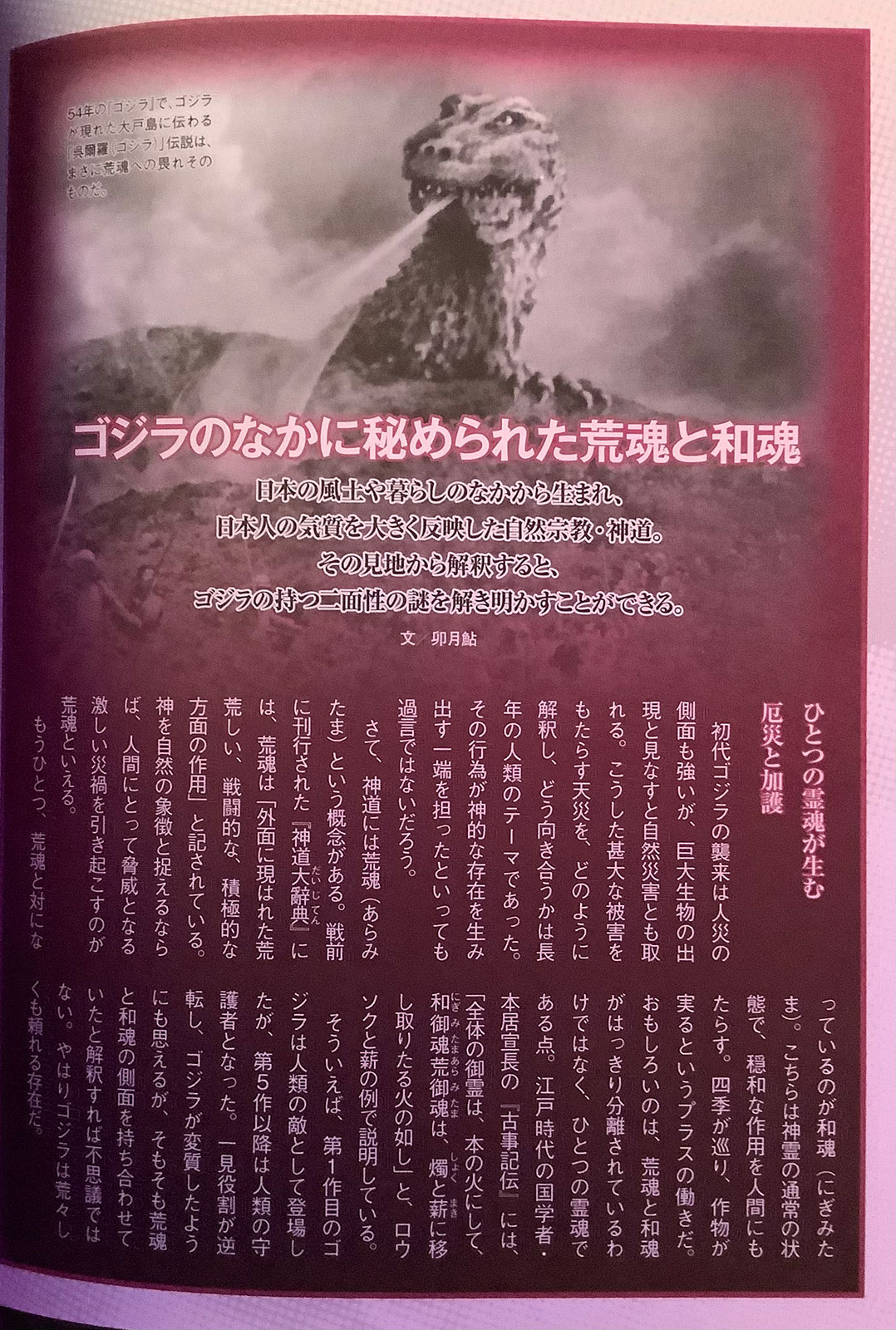5.21.2022 (revised 6.20.2022)
The rough soul and Japanese soul hidden in Godzilla

54年の「ゴジラ」で、ゴジラが現れた大戸島に伝わる「呉爾羅 (ゴジラ)」伝説は、まさに荒魂への畏れそのものだ。
The legend of “Godzilla,” which was handed down to Odo Island where Godzilla appeared in “Godzilla” in 1954, is exactly the fear of a rough soul.
ゴジラのなかに秘められた荒魂と和魂
The rough soul and Japanese soul hidden in Godzilla
日本の風土や暮らしのなかから生まれ、日本人の気質を大きく反映した自然宗教・神道。
Shinto is a natural religion that was born from the climate and lifestyle of Japan and greatly reflects the temperament of the Japanese people.
その見地から解すると、ゴジラの持つ二面怪の謎を解き明かすことができる。
From that point of view, it is possible to unravel the mystery of Godzilla’s two-sided mystery.
文/卯月鮎
Writing / Uzuki Ayu
ひとつの霊魂が生む
A soul is born
厄災と加護
Disaster and blessing
初代ゴジラの襲来は人災の 側面も強いが、巨大生物の出現と見なすと自然災害とも取 れる。こうした甚大な被害をもたらす天災を、どのように 解釈し、どう向き合うかは長年の人類のテーマであった。その行為が神的な存在を生み出す一端を担ったといっても過言ではないだろう。
The invasion of the first Godzilla has a strong aspect of man-made disaster, but if it is regarded as the emergence of giant creatures, it can be regarded as a natural disaster. How to interpret and deal with such a natural disaster that causes enormous damage has been the theme of humankind for many years. It is no exaggeration to say that the act played a part in creating a divine existence.
さて、神道には荒魂(あらみたま)という概念がある。戦前だいじてんに刊行された『神道大辭典』に は、荒魂は「外面に現れた荒荒しい、戦闘的な、積極的な 方面の作用」と記されている。神を自然の象徴と捉えるならば、人間にとって脅威となる激しい災禍を引き起こすのが荒魂といえる。
By the way, Shinto has the concept of Aramitama. In the “Shinto Dictionary” published in the prewar era, he describes Mitama as “a rough, combative, positive action that appears on the outside.” If God is regarded as a symbol of nature, it can be said that it is a rough soul that causes a severe disaster that threatens human beings.
“Aramitama (荒魂; literally “brazen soul” or “uncultured spirit”) is a Shintoism concept regarding a deity’s state of mind. This belief refers to a deity’s harsh and frequently cruel behavior. When a deity is within this state, they will desire havoc and decay to anything within their reach. The balance between Heaven and earth tips towards chaos, sickness becomes rampant, and people will never know rest.” (Source: Aramitama)
もうひとつ、荒魂と対になっているのが和魂(にぎみたま)。こちらは神霊の通常の状 態で、穏和な作用を人間にもたらす。四季が巡り、作物が実るというプラスの働きだ。おもしろいのは、荒魂と和魂がはっきり分離されているわけではなく、ひとつの霊魂である点。江戸時代の国学者・本居宣長の『古事記伝』には、「全体の御霊は、本の火にして、にぎみたまあらみたましょくまき和御魂荒御魂は、燭と薪に移取りたる火の如し」と、ロウソクと薪の例で説明している。
Another pair with Mitama is Nigimitama (Japanese soul). This is the normal state of the Holy Spirit, which has a mild effect on humans. It is a positive function that the four seasons go around and the crops grow. What is interesting is that the rough soul and the Japanese soul are not clearly separated, but are one soul. According to “Kojikiden” by Motoori Norinaga, a national scholar of the Edo period, “The whole spirit is turned into a fiery book, and the soul of Mitama is transferred to candles and firewood. It’s like a fire,” he explains with the example of candles and firewood.
The Japanese word mitama (御魂・御霊・神霊, ‘honorable spirit’) refers to the spirit of a kami or the soul of a dead person.[1] It is composed of two characters, the first of which, mi (御, honorable), is simply an honorific. The four souls are the ara-mitama (荒御霊・荒御魂, rude soul), the nigi-mitama (和御霊・和御魂, harmonious soul), the saki-mitama (幸御魂, happy soul) and the kushi-mitama (奇御霊・奇御魂, wondrous soul). According to the theory, each of the souls making up the spirit has a character and a function of its own; they all exist at the same time, complementing each other. Source: Wikipedia
そういえば、第1作目のゴジラは人類の敵として登場したが、第5作以降は人類の守 護者となった。一見役割が逆 転し、ゴジラが変質したようにも思えるが、そもそも荒魂と和魂の側面を持ち合わせていたと解釈すれば不思議では ない。やはりゴジラは荒々しも頼れる存在だ。
By the way, Godzilla in the first work appeared as an enemy of humanity, but after the fifth work, he became a guardian of humanity. At first glance, it seems that Godzilla has been transformed by reversing his role, but it is no wonder that he had the aspects of a rough soul and a Japanese soul in the first place. After all Godzilla is an existence that can be relied on wildly.
Source: ゴジラ完全解読 (宝島社, p 90)